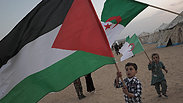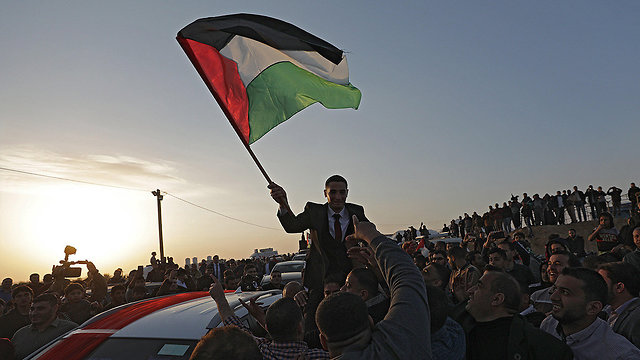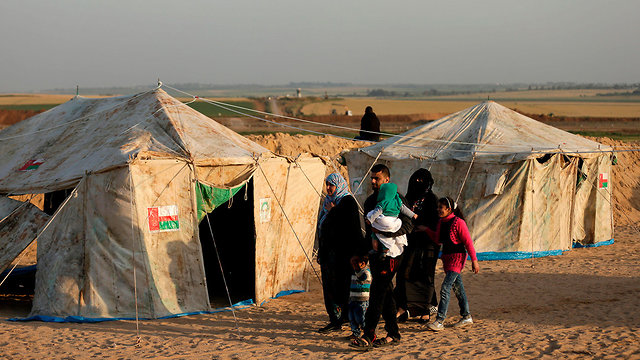
Palestinian children at March of Return
צילום: EPA
The full story behind the 'March of Return'
Op-ed: Hamas relies on the terrifying scene of tens of thousands of Palestinians awaiting its signal to swipe Israel with an unprecedented civil rights movement, to convince Israel to put enormous pressure on Abbas to lift his suffocating sanctions on Gaza and on Egypt to ease their part of the blockade and accelerate the reconciliation process.
In an increasingly despairing sphere of loss and abandonment, some local activists opted to change the repeated Friday incidents that are passing unnoticed of young futureless Gazans crowding at the borders like a herd of ducks, waiting for their souls to be mercilessly harvested by Israeli snipers.
With few tents set up in the buffer zone to symbolize the refugees’ plight, the activists hoped to re-humanize the Palestinian suffering and give it a face and a story instead of continuing to be reduced into passive statistics with an ever-declining importance.
The first activist to initiate this movement and set up a tent, in response to Trump’s hostile position on Palestinian refugees and Jerusalem, was Muthana al-Najjar, an independent journalist from the impoverished village of Khuzaa. His initiative was almost unheard of as he and his fellow activists were keen to keep the protest unaffiliated with Hamas or any other political group until the latter jumped in and insisted to take part in the organization of “the great march of return.”
Hamas assigned the protest mobilization task to its popular division “Al-'Amal al-Jamahiri,” and youth division “Al-Kutla al-Islamiya,” under Hani Miqbil and Mohammed Haniya, to crowd the largest number of protestors possible, and it has been incredibly efficient at that task despite Israeli attempts to kill the protest in the bud; whether by throwing leaflets on Gaza that strictly warns its residence from approaching the separation fence, or (allegedly) by intimidating transportation companies that if they carry protestors to the border zone their Erez permit to cross in/out of Gaza will be revoked, or by (as Hamas claims) commanding collaborators in Gaza to spread rumors and incite against the protest, or by deploying enormous military force at the borders.
In Gaza, the local media and TV channels, the social media and newspapers are all filled with calls to join the protest. And Hamas activists are actively circulating and spreading such calls far and wide; whether on social media, amongst their friends, in street talks, in schools, universities, shops, or even at the mosques. People tell me that wherever they go, they’d encounter someone who’d call on them to join “the great march” that would set Gaza free. And such calls are hard to ignore when living on the edge of death pushing the boundaries for survival with nothing at the end of the tunnel but more agony.
However, despite the Hamas leadership’s strict orders to its ranks to take an active part in the protest, neither Hamas leaders nor their immediate families are likely to put themselves at the risk that they’re inviting people to run at bare-chested.
Furthermore, although, Hamas firmly controls the march planning and mobilization from behind the scene, it remarkably nevertheless, hasn’t only been desperately keen to disassociate itself from the protest, but is even more keen to maintain the protest’s non-violent theme as it plans to deploy its security personnel in civil clothes amongst the protestors to prevent individual attempts to spoil the march with violence; even if by throwing rocks, or shouting hostile slogans.
Hamas knows that a single sign of violent attitudes would instantly give an alibi for Israel to exercise its most favorite performance of portraying Gazans as “swarms of terrorists” whose march necessitates on Israel to practice its “right to defend itself.”
Hamas is also keen to avoid any clashes with the Israeli army on the borders that would disperse the masses before their numbers peak; since its main tool is to display popular capacity to crowd Gazans around its promises. A card that is hoped to put Hamas strongly back on the international agenda as an unavoidable player in the Israeli-Palestinian conflict.
In the first stage, the protest will take the shape of setting up huge tents near the buffer zone where people could perform different activities, from singing to dancing to carrying signs that read “implement resolution 194.” Hamas will suffice with two objectives: To reallocate international attention to Gaza’s unbearable suffering that its population can no longer endure, and to signal out to Israel and the PA that the masses are on its side, and can use them to reproduce Samson’s cliché “let it fall on me and my enemies,” if it continues to be cornered with no alternatives to survive.
In this case, Israel’s use of force would be exactly what Hamas needs to solidify its message and spread the pictures of Gazan agony further around the world.
Nonetheless, Hamas wholeheartedly knows from early experiences that even if Israel eases the blockade, expands the fishing and farming zones, or even opens up the borders for people’s movement to assuage the protestors’ anger, such measures wouldn’t last long before they’re revoked again at the earliest opportunity. In addition, Netanyahu’s government crisis makes the former scenario highly unexpected since Bibi is setting on a very thin ice that he cannot afford the criticism that would follow rewarding Gaza for its revolt.
Therefore, Hamas relies on the terrifying scene of tens of thousands of Palestinians awaiting its signal to swipe Israel with an unprecedented civil rights movement, to convince the latter to put enormous pressure on Mahmoud Abbas to lift his suffocating sanctions on Gaza that made the beleaguered enclave greatly unlivable and on Egypt to ease their part of the blockade and accelerate the reconciliation process.
As the time goes on, Hamas hopes to normalize the scene of approaching the borders, the one forbidden area that is considered to be Gaza’s deadliest zone, amongst the beleaguered population in order to encourage others to follow their lead.
If Gaza’s suffering continues to be ignored, the march tone will be escalated accordingly between March 30 (Palestinian’s land day and Israel’s Passover) and May 15 (Israel’s independence and Palestinian’s Nakba “catastrophe” day). Until at some unexpected point, the despaired and ever-oppressed protestors will approach the fence, lift the gates and walk into Israel to as far as their feet could go, and demand to be treated as equal humans again. Nothing will deter such masses from continuing to swarm on Israel. Not even death.
Muhammad Shehada is a Palestinian writer and civil society activist from the Gaza Strip.













